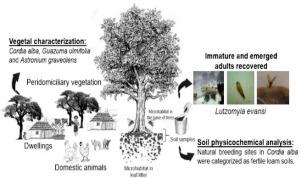当前位置:
X-MOL 学术
›
Acta Trop.
›
论文详情
Our official English website, www.x-mol.net, welcomes your feedback! (Note: you will need to create a separate account there.)
Development of Lutzomyia evansi immature stages in peridomiciliary environment in a leishmaniasis urban focus in the Colombian Caribbean.
Acta Tropica ( IF 2.7 ) Pub Date : 2020-05-11 , DOI: 10.1016/j.actatropica.2020.105523 Luis Gregorio Estrada 1 , Edgar Ortega 1 , Rafael José Vivero 2 , Eduar Elías Bejarano 1 , Horacio Cadena 2
Acta Tropica ( IF 2.7 ) Pub Date : 2020-05-11 , DOI: 10.1016/j.actatropica.2020.105523 Luis Gregorio Estrada 1 , Edgar Ortega 1 , Rafael José Vivero 2 , Eduar Elías Bejarano 1 , Horacio Cadena 2
Affiliation

|
In the Caribbean region of Colombia, Lutzomyia evansi is recognized as the vector for Leishmania infantum and Leishmania braziliensis. Identifying breeding sites and surveying abundance of immature phlebotomine sand flies in urban foci of leishmaniasis are useful tool to design new vector control strategies. The objective of this study was to describe the natural breeding sites of Lu. evansi in peridomiciliary vegetation in a peri-urban area of the Colombian Caribbean region. Between 2013 and 2015, 466 microhabitats were sampled, collecting 621 kg of soil samples. The explored microhabitats were bases and tree holes, fallen trees, animal caves, leaf litter, domestic animal shelters, and the inside of dwellings. The immature phlebotomines were recovered by direct search under the stereoscope and incubation of soil samples. In total, 103 microhabitats, associated with 17 arboreal species, were identified as natural breeding sites. Of 422 immature sandflies detected, 98.6% were found in soils at the base of the trees. Eight species of the genus Lutzomyia were identified, of which Lu. evansi (52.6%) was the most abundant, followed by Lu. rangeliana, Lu. cayennensis cayennensis, Lu. atroclavata, Lu. micropyga, Lu. trinidadensis, Lu. dubitans and Lu. gomezi. The arboreal species Cordia alba was the most used by phlebotomines for the development of their immature stages. From 63 natural breeding sites identified 268 immatures were recovered including 176 Lu. evansi. The accumulated precipitation showed correlation (R2 = 0.643, p = 0.013) with the abundance of developmental stages, which increased in September and October. The natural breeding sites of Lu. evansi exhibited a local pattern of occurrence dependent on rainfall. The physicochemical analysis of the soil samples showed that the natural sites for C. alba were categorized as fertile loam soils. This is the first systematic study that estimates the temporal variation of immature sand flies in peridomiciliary vegetation in a peri-urban focus of leishmaniasis in Colombia.
中文翻译:

哥伦比亚加勒比海地区以利什曼病为中心的周缘微生物环境中的伊斯氏菌不成熟阶段的发展。
在哥伦比亚的加勒比海地区,埃文氏菌被认为是婴儿利什曼原虫和巴西利什曼原虫的媒介。查明利什曼病城市疫源地的繁殖地点和调查未成熟的to虫沙蝇的数量是设计新的媒介控制策略的有用工具。这项研究的目的是描述Lu的自然繁殖地。哥伦比亚加勒比海地区近郊地区的远缘胶质植被中的埃文西。在2013年至2015年期间,共采样了466个微生境,收集了621公斤土壤样本。探索的微生境是基地和树洞,倒下的树木,动物洞穴,树叶凋落物,家畜庇护所以及住宅内部。通过在立体镜下直接搜索并孵育土壤样品,回收了未成熟的博洛酮。总共,与17个树栖物种相关的103个微生境被确定为自然繁殖地。在422种未成熟的沙蝇中,在树根土壤中发现了98.6%。确定了八种Lutzomyia属,其中Lu。埃文西(52.6%)最富裕,其次是卢。卢安利亚纳 cayennensis cayennensis,卢。卢阿特罗克拉瓦塔。陆py 特立尼达,卢。杜比坦和鲁。gomezi。树木植物Cordia alba是最成熟的不成熟植物。从63个自然繁殖点中发现了268个未成熟个体,包括176 Lu。埃文西 累积的降水与发育阶段的丰度表现出相关性(R2 = 0.643,p = 0.013),在9月和10月有所增加。鲁的自然繁殖地。伊万西(Evansi)表现出局部降雨模式,取决于降雨。对土壤样品的理化分析表明,C。alba的自然地点被归类为肥沃的壤土。这是第一个系统的研究,它估计了哥伦比亚利什曼病在城市周边地区未定殖的蝇per随时间的变化。
更新日期:2020-05-12
中文翻译:

哥伦比亚加勒比海地区以利什曼病为中心的周缘微生物环境中的伊斯氏菌不成熟阶段的发展。
在哥伦比亚的加勒比海地区,埃文氏菌被认为是婴儿利什曼原虫和巴西利什曼原虫的媒介。查明利什曼病城市疫源地的繁殖地点和调查未成熟的to虫沙蝇的数量是设计新的媒介控制策略的有用工具。这项研究的目的是描述Lu的自然繁殖地。哥伦比亚加勒比海地区近郊地区的远缘胶质植被中的埃文西。在2013年至2015年期间,共采样了466个微生境,收集了621公斤土壤样本。探索的微生境是基地和树洞,倒下的树木,动物洞穴,树叶凋落物,家畜庇护所以及住宅内部。通过在立体镜下直接搜索并孵育土壤样品,回收了未成熟的博洛酮。总共,与17个树栖物种相关的103个微生境被确定为自然繁殖地。在422种未成熟的沙蝇中,在树根土壤中发现了98.6%。确定了八种Lutzomyia属,其中Lu。埃文西(52.6%)最富裕,其次是卢。卢安利亚纳 cayennensis cayennensis,卢。卢阿特罗克拉瓦塔。陆py 特立尼达,卢。杜比坦和鲁。gomezi。树木植物Cordia alba是最成熟的不成熟植物。从63个自然繁殖点中发现了268个未成熟个体,包括176 Lu。埃文西 累积的降水与发育阶段的丰度表现出相关性(R2 = 0.643,p = 0.013),在9月和10月有所增加。鲁的自然繁殖地。伊万西(Evansi)表现出局部降雨模式,取决于降雨。对土壤样品的理化分析表明,C。alba的自然地点被归类为肥沃的壤土。这是第一个系统的研究,它估计了哥伦比亚利什曼病在城市周边地区未定殖的蝇per随时间的变化。


























 京公网安备 11010802027423号
京公网安备 11010802027423号